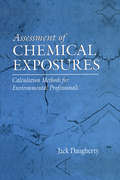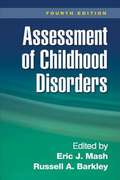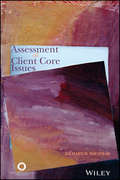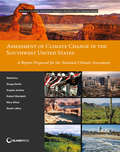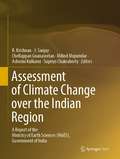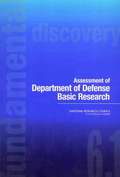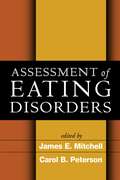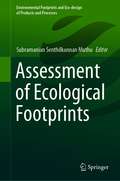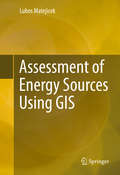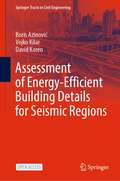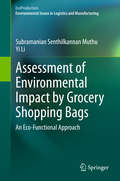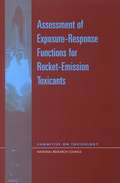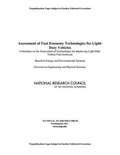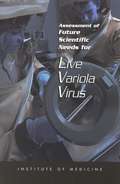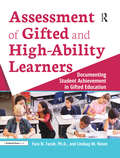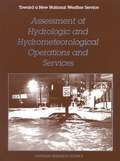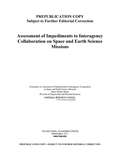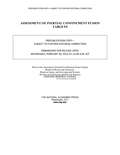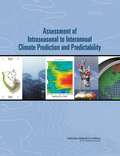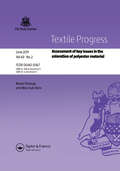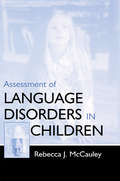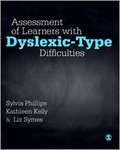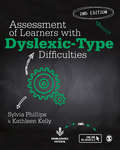- Table View
- List View
Assessment of Chemical Exposures: Calculation Methods for Environmental Professionals
by Jack E. DaughertyTraditionally, industrial hygienists and environmental engineers have been responsible for conducting chemical exposure assessments, however, this task is now becoming a team effort taken on by scientists, businessmen, and policymakers. Assessment of Chemical Exposures: Calculation Methods for Environmental Professionals addresses the expanding scope of exposure assessments in both the workplace and environment. It discusses the basics of gathering data and assessing exposure, including how to estimate exposure to chemicals using fundamental chemical engineering concepts. The book opens with a brief discussion on the history of exposure assessments and provides terms and nomenclature needed for communications between various disciplines involved in exposure assessments. The potential impact of chemical exposures on humans, the environment, and communities is discussed in detail The book also addresses modeling source generation, pathway transport, and receptor impact. With the clear explanations presented in this text, even a novice will be able to practice the art of exposure assessment.
Assessment of Childhood Disorders, Fourth Edition
by Eric Mash Russell BarkleyThis leading text and clinical guide offers best-practice recommendations for assessing a comprehensive array of child and adolescent mental health problems and health risks. Prominent authorities present evidence-based approaches that can be used in planning, implementing, and evaluating real-world clinical services. Coverage encompasses behavior disorders, mood disorders, anxiety disorders, developmental disorders, maltreatment, and adolescent problems. The volume emphasizes the need to evaluate clients' strengths as well as their deficits, and to take into account the developmental, biological, familial, and cultural contexts of problem behavior. New to This Edition Incorporates advances in knowledge on child and family disorders and evidence-based assessment. Chapters on bipolar disorder, suicidal and self-harming behaviors, posttraumatic stress disorder, early-onset schizophrenia, learning disabilities, and adolescent personality disorders.
Assessment of Client Core Issues
by Richard W. HalsteadThis monograph instructs counselors on how to better recognize, understand, and treat clients’ underlying problems. The model presented helps uncover the origin of these core concerns, provides a means to address them, and challenges counselors to move beyond the DSM to better serve their clients. This framework will also assist counselors in providing more targeted treatment plans. *Requests for digital versions from the ACA can be found on wiley.com. *To request print copies, please visit the ACA website.
Assessment of Climate Change in the Southwest United States: A Report Prepared for the National Climate Assessment (NCA Regional Input Reports)
by Gregg Garfin Mary Black Sarah Leroy Angela Jardine Robert MeridethPrepared for the 2013 National Climate Assessment and a landmark study in terms of its breadth and depth of coverage, this report blends the contributions of 120 experts in climate science, economics, ecology, engineering, geography, hydrology, planning, resources management, and other disciplines to provide the most comprehensive, and understandable, analysis to date about climate and its effects on the people and landscapes of Arizona, California, Colorado, Nevada, New Mexico, and Utah--including the U. S. -Mexico border region and the lands of Native Nations. What is the climate of the Southwest like today? What has it been like in the past, and how is it projected to change over the 21st century? How will that affect water resources, ecosystems, agricultural production, energy supply and delivery, transportation, human health, and a host of other areas? How vulnerable is the region to climate change? What else do we need to know about it, and how can we limit its adverse effects?In addressing these and other questions, the book offers decision makers and stakeholders a substantial basis from which to make informed choices that will affect the well-being of the region's inhabitants in the decades to come.
Assessment of Climate Change over the Indian Region: A Report of the Ministry of Earth Sciences (MoES), Government of India
by R. Krishnan J. Sanjay Chellappan Gnanaseelan Milind Mujumdar Ashwini Kulkarni Supriyo ChakrabortyThis open access book discusses the impact of human-induced global climate change on the regional climate and monsoons of the Indian subcontinent, adjoining Indian Ocean and the Himalayas. It documents the regional climate change projections based on the climate models used in the IPCC Fifth Assessment Report (AR5) and climate change modeling studies using the IITM Earth System Model (ESM) and CORDEX South Asia datasets. The IPCC assessment reports, published every 6–7 years, constitute important reference materials for major policy decisions on climate change, adaptation, and mitigation. While the IPCC assessment reports largely provide a global perspective on climate change, the focus on regional climate change aspects is considerably limited. The effects of climate change over the Indian subcontinent involve complex physical processes on different space and time scales, especially given that the mean climate of this region is generally shaped by the Indian monsoon and the unique high-elevation geographical features such as the Himalayas, the Western Ghats, the Tibetan Plateau and the adjoining Indian Ocean, Arabian Sea, and Bay of Bengal. This book also presents policy relevant information based on robust scientific analysis and assessments of the observed and projected future climate change over the Indian region.
Assessment of Commercial Space Platforms for Earth Science Instruments: Report Series?committee On Earth Science And Applications From Space
by Space Studies Board Division on Engineering and Physical Sciences National Academies of Sciences, Engineering, and Medicine Committee on Earth Science and Applications from SpaceSpace-based Earth observations enable global observations of the land surface, biosphere, solid Earth, atmosphere, cryosphere, and oceans. Earth observations from space, combined with data acquired from in situ and ground-based instruments, help scientists understand the components of the Earth system and their interactions and enable wide-ranging applications, including forecasts of weather and air quality, projections of future climate, management of natural resources, ecological forecasting, disaster management, drought and wildfire prediction, and the mapping and prediction of vector borne/animal diseases. At the request of NASA Earth Science Division, this report assesses the potential use of a proposed multi-user, robot-tended, uncrewed commercial space platform as a potential host for a large number of Earth remote sensing instruments. Assessment of Commercial Space Platforms for Earth Science Instruments evaluates the utility and practicality of a platform in a Sun-synchronous orbit, capable of hosting 20 or more instruments.
Assessment of Department of Defense Basic Research
by National Research Council of the National AcademiesThe Department of Defense (DOD) supports basic research to advance fundamental knowledge in fields important to national defense. Over the past six years, however, several groups have raised concern about whether the nature of DOD-funded basic research is changing. The concerns include these: Funds are being spent for research that does not fall under DOD's definition of basic research; reporting requirements have become cumbersome and onerous; and basic research is handled differently by the three services. To explore these concerns, the Congress directed DOD to request a study from the National Research Council (NRC) about the nature of basic research now being funded by the Department. Specifically the NRC was to determine if the programs in the DOD basic research portfolio are consistent with the DOD definition of basic research and with the characteristics associated with fundamental research.
Assessment of Eating Disorders
by James Mitchell Carol B. PetersonConcise and practical yet comprehensive, this unique book provides a clear framework and a range of up-to-date tools for assessing patients with eating disorders. Leading clinicians and researchers describe the nuts and bolts of using diagnostic interviews, standardized databases, structured instruments, self-report and family-based measures, medical and nutritional assessment, ecological momentary assessment, and strategies for evaluating body image disturbance. Concrete examples and sample forms are included throughout, and the concluding chapter discusses how to use assessment data in individualized treatment planning.
Assessment of Ecological Footprints (Environmental Footprints and Eco-design of Products and Processes)
by Subramanian Senthilkannan MuthuThis book highlights the concepts and assessment methods of Ecological Footprints. Ecological footprint is defined as, ”a measure of how much area of biologically productive land and water an individual, population or activity requires to produce all the resources it consumes and to absorb the waste it generates, using prevailing technology and resource management practices”. Developed in 1992 by William Rees, it was the first footprint developed followed by other footprints such as Carbon, Water and Energy. Assessment of Ecological footprints strive for comparing consumption footprint to biological capacity. This book presents five interesting chapters pertaining to the assessment of Ecological Footprints.
Assessment of Energy Sources Using GIS
by Lubos MatejicekThis volume is a comprehensive guide to the use of geographic information systems (GIS) for the spatial analysis of supply and demand for energy in the global and local scale. It gathers the latest research and techniques in GIS for spatial and temporal analysis of energy systems, mapping of energy from fossil fuels, optimization of renewable energy sources, optimized deployment of existing power sources, and assessment of environmental impact of all of the above. Author Lubos Matejicek covers GIS for assessment a wide variety of energy sources, including fossil fuels, hydropower, wind power, solar energy, biomass energy, and nuclear power as well as the use of batteries and accumulators. The author also utilizes case studies to illustrate advanced techniques such as multicriteria analysis, environmental modeling for prediction of energy consumption, and the use of mobile computing and multimedia tools.
Assessment of Energy-Efficient Building Details for Seismic Regions (Springer Tracts in Civil Engineering)
by Boris Azinović Vojko Kilar David KorenThis open access book presents a methodology for the assessment of structural building details, taking into account the contemporary guidelines for earthquake-resistant and energy-efficient buildings. A review of structural details for energy-efficient buildings revealed that in some cases the structural system is interrupted, leading to solutions which are not suitable for earthquake-prone regions. Such typical examples would be the use of thermal insulation under the building foundation and reduction of the load-bearing elements’ dimensions – also at the potential locations of plastic hinges which are crucial for the dissipation of seismic energy. The proposed methodology of assessment favours a collaboration of architects, engineers, contractors and investors in the early stage of building design. By this the methodology enables efficient decision-making and contributes to a selection of optimal building structural details.The book starts by presenting the typical structural details of the thermal envelope of energy-efficient buildings together with the scientific background required for understanding the process of detail development from all the relevant aspects. Over 20 examples of most frequent details are described and analysed to raise awareness of the importance of earthquake resistance, sustainability, energy-efficiency and thermal comfort for users.
Assessment of Environmental Impact by Grocery Shopping Bags: An Eco-Functional Approach (EcoProduction)
by Yi Li Subramanian Senthilkannan MuthuThis book reviews the manufacturing processes of different shopping bags used for grocery purposes, life cycle impacts, modelling of life cycle impacts, carbon and eco-footprints in different countries, consumption of shopping bags in different countries, consumer behaviour of shopping bags in various countries and its relation to eco-impact, assessment of functionality of shopping bags, concept and framework of eco-functional assessment of shopping bags, biodegradation of shopping bags, etc.
Assessment of Exposure-Response Functions for Rocket-Emission Toxicants
by Subcommittee on Rocket-Emission ToxicantsThe U.S. Air Force is developing a model to assist commanders in determining when it is safe to launch rocket vehicles. The model estimates the possible number and types of adverse health effects for people who might be exposed to the ground cloud created by rocket exhaust during a normal launch or during an aborted launch that results in a rocket being destroyed near the ground.Assessment of Exposure-Response Functions for Rocket-Emmission Toxicants evaluates the model and the data used for three rocket emission toxicants: hydrogen chloride, nitrogen dioxide, and nitric acid.
Assessment of Failed Federalism in Iraq: Federal in Name Only
by Hemin R.A. AkreyiAkreyi investigates the development of federal relations in Iraq from the adoption of the new Federal Constitution in 2005 to the Kurdistan independence referendum in 2017.The book highlights the dysfunctionality of the Iraqi federal system even after the independence referendum and shows the true picture of the key issues between the Kurdistan Region and the Iraqi government in Baghdad. This informative content is presented in an easy-to-grasp manner, originating primarily from face-to-face interviews with relevant elites and decision-makers in Iraq as well as foreign diplomats.A valuable source for academics, researchers, journalists, and students of politics and international relations at the undergraduate and postgraduate levels in all universities, especially in the West and Middle East.
Assessment of Fuel Economy Technologies for Light-Duty Vehicles
by National Research Council of the National AcademiesVarious combinations of commercially available technologies could greatly reduce fuel consumption in passenger cars, sport-utility vehicles, minivans, and other light-duty vehicles without compromising vehicle performance or safety. Assessment of Technologies for Improving Light Duty Vehicle Fuel Economy estimates the potential fuel savings and costs to consumers of available technology combinations for three types of engines: spark-ignition gasoline, compression-ignition diesel, and hybrid. According to its estimates, adopting the full combination of improved technologies in medium and large cars and pickup trucks with spark-ignition engines could reduce fuel consumption by 29 percent at an additional cost of $2,200 to the consumer. Replacing spark-ignition engines with diesel engines and components would yield fuel savings of about 37 percent at an added cost of approximately $5,900 per vehicle, and replacing spark-ignition engines with hybrid engines and components would reduce fuel consumption by 43 percent at an increase of $6,000 per vehicle. The book focuses on fuel consumption--the amount of fuel consumed in a given driving distance--because energy savings are directly related to the amount of fuel used. In contrast, fuel economy measures how far a vehicle will travel with a gallon of fuel. Because fuel consumption data indicate money saved on fuel purchases and reductions in carbon dioxide emissions, the book finds that vehicle stickers should provide consumers with fuel consumption data in addition to fuel economy information.
Assessment of Future Scientific Needs for Live Variola Virus
by Institute of MedicineIn 1980, the World Health Organization (WHO) officially declared that smallpox had been eradicated. In 1986, WHO's international Ad Hoc Committee on Orthopox Virus Infections unanimously recommended destruction of the two remaining official stocks of variola virus, one at the Centers for Disease Control and Prevention and the other at the VECTOR laboratory in Siberia. In June 1999, WHO decided to delay the destruction of these stocks. Informing that decision was Assessment of Future Scientific Needs for Variola Virus, which examines:-- Whether the sequenced variola genome, vaccinia, and monkey pox virus are adequate for future research or whether the live variola virus itself is needed to assist in the development of antiviral therapies.-- What further benefits, if any, would likely be gained through the use of variola in research and development efforts related to agent detection, diagnosis, prevention, and treatment.-- What unique potential benefits, if any, the study of variola would have in increasing our fundamental understanding of the biology, host-agent interactions, pathogenesis, and immune mechanisms of viral diseases.
Assessment of Gifted and High-Ability Learners: Documenting Student Achievement in Gifted Education
by Joan L. GreenAssessment of Gifted and High-Ability Learners equips readers with the knowledge and skills to evaluate and document student progress using a cyclical systematic process. This book:
Assessment of Hydrologic and Hydrometeorological Operations and Services: TOWARD A NEW NATIONAL WEATHER SERVICE
by National Weather Service Modernization CommitteeAn Assessment of Hydrologic and Hydrometeorological Operations and Services.
Assessment of Impediments to Interagency Collaboration on Space and Earth Science Missions
by National Research Council of the National AcademiesThrough an examination of case studies, agency briefings, and existing reports, and drawing on personal knowledge and direct experience, the Committee on Assessment of Impediments to Interagency Cooperation on Space and Earth Science Missions found that candidate projects for multiagency collaboration in the development and implementation of Earth-observing or space science missions are often intrinsically complex and, therefore costly, and that a multiagency approach to developing these missions typically results in additional complexity and cost. Advocates of collaboration have sometimes underestimated the difficulties and associated costs and risks of dividing responsibility and accountability between two or more partners; they also discount the possibility that collaboration will increase the risk in meeting performance objectives. This committee's principal recommendation is that agencies should conduct Earth and space science projects independently unless: It is judged that cooperation will result in significant added scientific value to the project over what could be achieved by a single agency alone; or Unique capabilities reside within one agency that are necessary for the mission success of a project managed by another agency; or The project is intended to transfer from research to operations necessitating a change in responsibility from one agency to another during the project; or There are other compelling reasons to pursue collaboration, for example, a desire to build capacity at one of the cooperating agencies. Even when the total project cost may increase, parties may still find collaboration attractive if their share of a mission is more affordable than funding it alone. In these cases, alternatives to interdependent reliance on another government agency should be considered. For example, agencies may find that buying services from another agency or pursuing interagency coordination of spaceflight data collection is preferable to fully interdependent cooperation.
Assessment of Inertial Confinement Fusion Targets
by National Research Council Division on Engineering and Physical Sciences Board on Physics and Astronomy Board on Energy and Environmental Systems Panel on the Assessment of Inertial Confinement Fusion TargetsIn the fall of 2010, the Office of the U.S. Department of Energy's (DOE's) Secretary for Science asked for a National Research Council (NRC) committee to investigate the prospects for generating power using inertial confinement fusion (ICF) concepts, acknowledging that a key test of viability for this concept--ignition --could be demonstrated at the National Ignition Facility (NIF) at Lawrence Livermore National Laboratory (LLNL) in the relatively near term. The committee was asked to provide an unclassified report. However, DOE indicated that to fully assess this topic, the committee's deliberations would have to be informed by the results of some classified experiments and information, particularly in the area of ICF targets and nonproliferation. Thus, the Panel on the Assessment of Inertial Confinement Fusion Targets ("the panel") was assembled, composed of experts able to access the needed information. The panel was charged with advising the Committee on the Prospects for Inertial Confinement Fusion Energy Systems on these issues, both by internal discussion and by this unclassified report. A Panel on Fusion Target Physics ("the panel") will serve as a technical resource to the Committee on Inertial Confinement Energy Systems ("the Committee") and will prepare a report that describes the R&D challenges to providing suitable targets, on the basis of parameters established and provided to the Panel by the Committee. The Panel on Fusion Target Physics will prepare a report that will assess the current performance of fusion targets associated with various ICF concepts in order to understand: 1. The spectrum output; 2. The illumination geometry; 3. The high-gain geometry; and 4. The robustness of the target design. The panel addressed the potential impacts of the use and development of current concepts for Inertial Fusion Energy on the proliferation of nuclear weapons information and technology, as appropriate. The Panel examined technology options, but does not provide recommendations specific to any currently operating or proposed ICF facility.
Assessment of Interseasonal to Interannual Climate Prediction and Predictability
by National Research Council of the National AcademiesMore accurate forecasts of climate conditions over time periods of weeks to a few years could help people plan agricultural activities, mitigate drought, and manage energy resources, amongst other activities; however, current forecast systems have limited ability on these time- scales. Models for such climate forecasts must take into account complex interactions among the ocean, atmosphere, and land surface. Such processes can be difficult to represent realistically. To improve the quality of forecasts, this book makes recommendations about the development of the tools used in forecasting and about specific research goals for improving understanding of sources of predictability. To improve the accessibility of these forecasts to decision-makers and researchers, this book also suggests best practices to improve how forecasts are made and disseminated.
Assessment of Key Issues in the Coloration of Polyester Material (Textile Progress Ser.)
by Renzo ShameyThis book addresses the problems in the dyeing of polyester textile materials in various forms and provides an overview of various textile operations for polyester. It presents various key steps and critical factors involved in the production of dyed polyester textile materials.
Assessment of Language Disorders in Children
by Rebecca J. McCauleyThis book constitutes a clear, comprehensive, up-to-date introduction to the basic principles of psychological and educational assessment that underlie effective clinical decisions about childhood language disorders. Rebecca McCauley describes specific commonly used tools, as well as general approaches ranging from traditional standardized norm-referenced testing to more recent ones, such as dynamic and qualitative assessment. Highlighting special considerations in testing and expected patterns of performance, she reviews the challenges presented by children with a variety of problems--specific language impairment, hearing loss, mental retardation, and autism spectrum disorders. Three extended case examples illustrate her discussion of each of these target groups. Her overarching theme is the crucial role of well-formed questions as fundamental guides to decision making, independent of approach.Each chapter features lists of key concepts and terms, study questions, and recommended readings. Tables throughout offer succinct summaries and aids to memory.Students, their instructors, and speech-language pathologists continuing their professional education will all welcome this invaluable new resource. Distinctive features include: A comprehensive consideration of both psychometric and descriptive approaches to the characterization of children's language A detailed discussion of background issues important in the language assessment of the major groups of children with language impairment Timely information on assessment of change--a topic frequently not covered in other texts Extensive guidance on how to evaluate individual norm-referenced measures for adoption An extensive appendix listing about 50 measures used to assess language in children A test review guide that can be reproduced for use by readers.
Assessment of Learners with Dyslexic-Type Difficulties
by Dr Kathleen S. Kelly Liz Symes Sylvia PhillipsThis comprehensive guide enables teachers to understand a range of approaches to the assessment of children with dyslexic-type difficulties. Linking theory, research and practice, practitioners will gain critical knowledge of procedures to analyse, interpret and use in appropriate assessments which will facilitate setting targets for teaching. The book covers: - how to use both informal and formal assessment procedures - frameworks for evaluating published and teacher-made assessments - the professional development needs of any teacher involved in assessment Ideal for those training to be specialist teachers of learners with dyslexia, this text is equally useful to all teachers and SENCOS (Special Educational Needs Co-ordinators) and complements the authors' book Teaching Literacy to Learners with Dyslexia to provide comprehensive guidance for assessing and teaching learners with dyslexic-type difficulties. Sylvia Phillips is an experienced Special Educational Needs educator, and currently leads Glyndwr University's specialist course for teachers of learners with dyslexia. Kath Kelly is Programme Leader for the Masters in Specific Learning Difficulties, Manchester Metropolitan University. Liz Symes is Senior Lecturer in SEN (Special Educational Needs) and Professional Studies, Manchester Metropolitan University.
Assessment of Learners with Dyslexic-Type Difficulties
by Dr Kathleen S. Kelly Sylvia PhillipsReinforcing best practice techniques, the second edition of this specialist guide for the assessment of learners with dyslexic-type difficulties includes: - a new chapter on The Implications of Co-existing Specific Learning Difficulties - updates to legislation including the SEND Code of Practice - updates to specific diagnostic tests - examples of interpreting test profiles - photocopiable resources available to download from the website This comprehensive guide enables teachers to understand a range of approaches to the assessment of children with dyslexic-type difficulties. It is an essential companion for those training to be specialist teachers of learners with dyslexia and a useful resource for all SENCOs, and teachers new or experienced.
